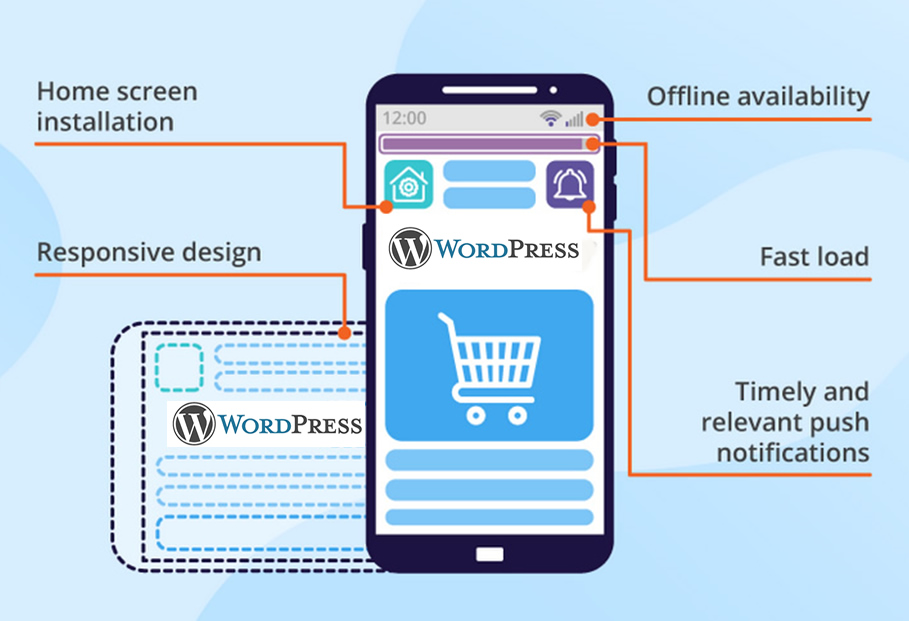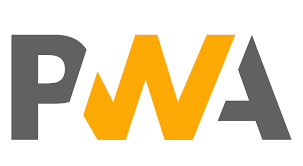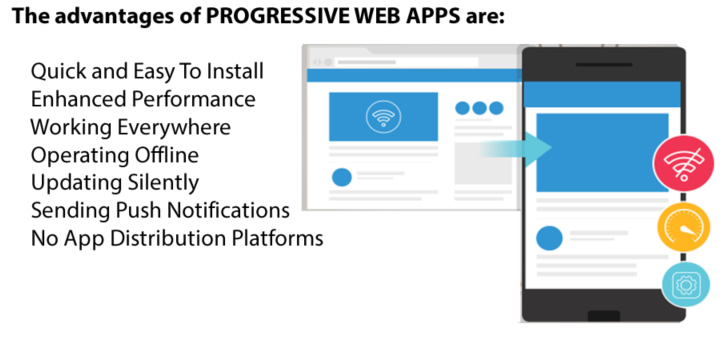Progressive Web APPS
Contact us today to discuss modifying your current website to work as an APP .
TURN YOUR WEBSITE INTO AN APP!
The cost is very low compared to developing a native APP! The APP files plugin to your website.
FROM JUST R 800
Drop us a line for a detailed quote!
The PWA will sit on top your WordPress CMS, data updating, and site management will remain the same. Users on accessing your site on their mobile phones will be offered the option to install the APP on their device, this will then provide them with APP like experience, offline accessibility, fast access during high-load or poor network coverage in their area, push notifications, quick short-cut menu links to important Events, Information or Promotions



WHAT IS A PWA?
A PWA is a web app which uses next-generation application programming interfaces (APIs) to incorporate features typically associated with native apps. These features include the ability to work offline, support for directly accessing a device’s storage and other hardware resources, and an interface resembling a native app rather than a website.
The APIs used to build PWA’s have become available only within the last few years. When combined with other components, including HTTPS, service workers, and a manifest file, these APIs allow PWAs to perform functions which historically were impossible for an application running inside a browser.
PWA CHARACTERISTICS
The capabilities of a PWA can vary, but often include the following:
- Offline access.
- PWA’s work even if a device loses its Internet connection, so your customers will no longer have their experience interrupted by spotty WiFi.
- User experience
- By accessing hardware directly and using native interfaces, PWA’s provide a more responsive user experience, improving user engagement with features like push notifications.
INSTALLABILITY
- PWA’s can be accessed through a web browser, eliminating download times while providing users with the option of accessing the app directly on their device.
- Security
- PWA’s pass network requests through service workers, minimizing their interactions with the internet.
- Discoverability
- PWA’s can be accessed and used right from a link in a search engine or on social media, exposing them to far more potential users than a visit to even the most popular app store.
- Cross-browser compatibility.
- PWA’s work across all modern browsers, including Chrome, Edge, Firefox, and Safari.
WHY USE A PWA
The features offered by PWAs increase user engagement and, by extension, conversion rates. Conventional web apps only work when a device is online and can’t deliver messages through native device interface features such as push notifications. With a PWA, a brand can build an eCommerce app that lets customers browse listings offline or announce new deals through push notifications.
PWAs also improve user retention with their superior performance. As many as one in five apps will be used only a single time due in part to performance issues like slow loading speed or responsiveness. After a user’s first visit, a PWA will load almost immediately. If you face challenges such as high abandonment rates for your apps or low levels of repeat site visits, you might consider using a PWA to remedy these issues.
In addition, PWAs update far more quickly than native apps. Instead of waiting for an update to finish installing, users will be able to get back to whatever they were doing quickly.
PWAs offer the advantage of access to device hardware features as well, such as those which report a smartphone’s precise geographic location. This lets you target customers in specific locations or market to a local audience.
Let’s take a look at the results that other well-known brands have achieved as a direct consequence of launching PWAs.
- Alibaba boosted mobile web conversions by 76%, saw 14% more active users on iOS and 30% on Android
- Debenhams saw a 40% increase in mobile revenue, a 20% increase in conversions, and above market online growth
- Pinterest saw a 40% boost in total time spent, 44% growth in user generated ad revenue, and 60% more core engagement
- Forbes got a 43% increase in sessions per user, a 20% improvement in ad viewability, and 100% more engagement
- BMW saw a 30% increase in CTR to their sales site, 4X faster load times, 50% growth in mobile users, and 49% more organic traffic
- MakeMyTrip boosted page speed by 38%, tripled conversion rates, and saw a 160% increase in shopper sessions
- AliExpress boosted conversion rates for new users by 104% (+82% on iOS) and saw 74% increase in time spent per session with 2x more pages visited per session
- com saw 38% more conversions, a 10% longer average session, 40% lower bounce rate – and an overall 30% faster page load time
- Wego tripled ad CTR, and saw 26% more visitors and 95% more conversions overall. On iOS, they got an impressive 50% boost in conversion and a 35% increase in session duration
- Treebo saw a 4x increase in conversions year on year. Repeat users converted 3x higher.
- Tinder more than halved loading times from 11.91 seconds to 4.69 seconds and saw engagement up across the board with a PWA 90% smaller than their native app
How are all these amazing results possible?
A lot of it boils down to the fact that PWAs provide a much better user experience, and great business results flow from that
